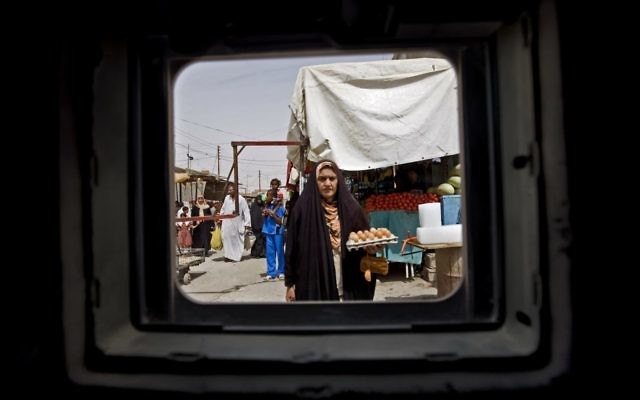Tackling photography Head On
The work of 900 photographers across 150 exhibitions around Sydney will feature in the annual Head On Photo Festival to take place throughout May. Director Moshe Rosenzveig tells Phoebe Roth what’s new this year.
NOW into its 11th year, the acclaimed Head On photo competition is not only continuing to grow, but is very much evolving with the times.
The flagship fixture of the annual festival of the same name, the Head On portrait prize last year expanded to include a mobile-phone photography category, and for the first time this year, opened a student category.
The brainchild of Israeli-born photographer Moshe Rosenzveig, the competition attracts entries from around Australia and overseas, indeed priding itself on representing a global selection from the best emerging and established photographers.
“The competition, in a way, is the centre of the whole festival,” Rosenzveig, director of Head On, says. “The idea is really to give people an excuse to take pictures.”
This year’s entries have been reduced to 130 finalists, with the winners to be announced at the festival’s official opening on May 1, set to share in $50,000 worth of prizes.
“[The competition] has a very high reputation,” Rosenzveig adds. “We took portraits last year to New York, to China and to Auckland. And this year we are taking the show to New York and to LA.”
The festival itself began in 2010. “Everything started small,” Rosenzveig recalls. “And then it grew bigger and bigger and bigger.”
This year, with the support of the City of Sydney, Head On will have a base at the Sydney Town Hall from May 1-10.
“This year we have a hub – we have a space that is going to be the main space with a lot of shows all in one spot,” enthuses Rosenzveig.
Beyond exhibitions, there will be workshops, talks and so forth – including many compact sessions accessible to the full-time worker.
“Bring your lunch with you, and get inspired by some amazing stuff,” Rosenzveig says.
The festival welcomes back acclaimed American photographer Benjamin Lowy. Beginning his career covering the Iraq War in 2003, Lowy has photographed major news events worldwide.
“He’s won every prize under the sun,” says Rosenzveig.
In addition, he has been a leader in mobile-phone photography for professional photojournalism, including shooting the first Time magazine cover taken with a mobile phone. With close to 170,000 followers on Instagram, Rosenzveig notes that Lowy is skilfully capitalising on the rise and rise of social media.
Rosenzveig – himself a photojournalist, commercial photographer, educator and TV producer/director – has had his work screened, published and exhibited in Australia and overseas for the past 30 years. Having complemented his photography, film and multimedia work with teaching and lecturing at universities and institutions, Rosenzveig is now focusing heavily on the annual festival.
In terms of photographic highlights of the festival, he cannot stop at one. American photographer Sandro Miller has re-created iconic images through the history of photography using actor John Malkovich to play the main roles.
His exhibition, titled Malkovich, Malkovich, Malkovich; Homage to Photographic Masters will be on at the Black Eye Gallery in Darlinghurst from April 28.
French photographer Georges Pacheco has done a series about breastfeeding, titled Amalthée, derived from the name of the goat that nursed infant Zeus according to Greek mythology.
Rosenzveig notes that Pacheco’s images, which are akin to Italian or Dutch Renaissance painting, are very powerful – even confronting.
He draws attention to one in particular which depicts a caucasian mother feeding a child with dark skin. “You look at it and you kind of just stop,” he says of the piece, which is among the director’s picks for the festival.
Meanwhile, young Chinese photographer Shunzan Fan seeks to capture the importance of the dreamscape, regardless of its basis in reality, in Between Heaven and Earth at the Stanley Street Gallery.
The works are all staged pictures of everyday people who pose in front of their “dreams”, being backgrounds drawn by the artist.
Former Iranian wedding photographer Ramak Bamzar presents Iranian Wedding, which encompasses a selection of photographs from weddings she captured in a small town called Karaj between 2005 and 2008.
“The interesting thing, the comment without saying anything, is about the status of women,” says Rosenzveig of the exhibition to be held at Sydney Lower Town Hall. “They are definitely showing another side of Iran that is not very visible.”
Indeed, Rosenzveig says a wide range of social issues are covered in the work across the festival.
Stepping outside the gallery, an installation project at Darling Harbour will see very large images on cubes in the middle of the harbour for the whole of May. There are three photographers involved in this unique project, including one who has done underwater photography.
Rosenzveig encourages people to come along and check out the festival in any capacity that suits them.
“Photography is everywhere. Everyone takes photos. It’s a valuable way of communicating with family and friends,” he says.
“If people are interested, I would highly recommend they come to the Town Hall, and at least collect the program.”
For more information on the Head On program, visit www.headon.com.au.
PHOEBE ROTH
A shot by American photographer Benjamin Lowy, who will exhibit his work as part of the Head On festival.


comments